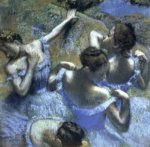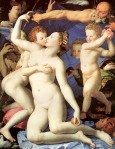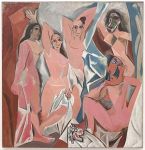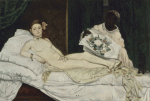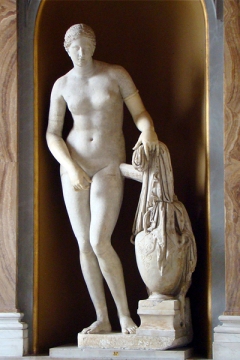
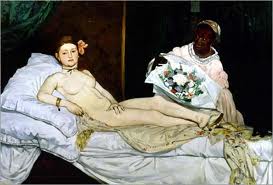
Knidian Aphrodite Olympia
Praxiteles, c.350 BCE Edouard Manet, 1863
Marble, 6′ 8″ Oil on canvas, 130 x 190 cm
Vatican Museums, Rome Musee d’Orsay, Paris
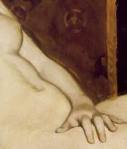
The history of the female nude in art is charged with control issues of feminine sexual power. The nude female’s sexuality can be owned by her, or its ownership and control can be transferred to the viewer by how the artist chooses pose, gaze and the context of the nude; hence the dynamics of the viewing experience.
A good place to begin the history of the female nude is with the ‘Venus pudica’ pose where an idealized female figure is depicted covering her pubis with her hand. So powerful is this pose that it defines the terms of feminine sexuality rooted in passivity, vulnerability and shame. Even after centuries, feminine sexuality in art was influenced by the historic use of this pose and was not publicly challenged until the 19th century. At a time when artists in France demanded artistic freedom, and Napoleon III permitted works rejected by the Salon to have their own exhibition in the Salon des Refuses, Manet submitted a work of art that served as a turning point to how the female nude could be depicted: Luncheon on the Grass (1863).


Luncheon on the Grass
Edouard Manet, 1863
oil on canvas, 7′ x 8’8″
Musee d’Orsay, Paris
The artist Praxiteles, in 350 bce, created the first cult statue of a goddess to be represented completely nude: the Knidian Aphrodite.[1] He posed her with her hand covering her pubis, unlike the male sculpture of the time where no special attention was given to their sexual organs. This pose solidified a new point in the history of art; it privileged the female over the male nude and sexually defined the represented woman by her pubis and, on that account, kept her in a perpetual state of vulnerability.[2] According to Salomon, this pose, named the ‘Venus Pudica’, established the artistic codes of female nudity as fetishized, and provided the visual basis for the concomitant unequal power relations.[3]
The origins of the Venus pudica pose were a culmination of the views towards women expressed in ancient Greek mythology and philosophy. Greek mythology often portrayed women as sexually tempting objects who were vulnerable and objectified.[4] Aristotle wrote of the concept of ‘sophrosyne’ or the ‘soundness of mind’.[5] This quality was said to come from within a man, but had to be externally exerted from outside in a woman.[6] Therefore, modesty and sexual self-control must be imposed upon a female, hence the hand covering the pubis in an act of external control.[7] The Venus pudica pose became a tradition and was widely reproduced in many works of Greek art for centuries. The Capitoline Venus sculpted almost 200 years after Praxiteles’ sculpture, used this pose but was sculpted with mindless disregard of its origin. This shows that over time, a complete acceptance of this pose developed as a depiction of female vulnerability and lack of power.
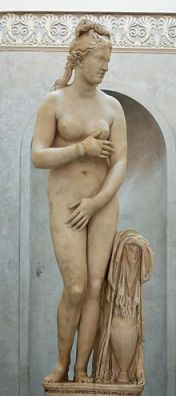
Capitoline Venus
2nd Century AD
Marble
National Gallery of Art, Washington
The French Royal Academy was founded in 1648. At this time, the female nude in art symbolized the same qualities defined by the ‘Venus pudica’ pose introduced in 350 bce. It was considered ‘good taste’ for academic artists to portray the female nude as vulnerable, powerless, and ideal, often as a goddess who innocently postured herself as sexually available to the viewer. As late as the 19th century the Venus pudica pose had become the classic pose assumed by models in academic learning situations, and was represented as such in many paintings and prints of the academy per se.[8] According to the French Royal Academy, historic painting was based on subjects from ancient or modern history, classical mythology, or the Scriptures, and required a thorough knowledge of important literary and historical texts.[9]
It was not until a group of French artists in the mid 1800’s challenged the academic principles and philosophies and began to exert the idea of artistic freedom. New styles such as Realism and impressionism emerged from classical art. Soon followed other styles like fauvism, cubism, abstraction and surrealism. Artists moved away from painting ideal scenes, to painting both traditional subjects (like the female nude) and non-traditional subjects in contemporary contexts with new artistic freedom. This new movement, beginning with Manet, marked the beginning of Modern Art and made room for new sexual dynamics to be explored in the depiction of the female nude.
In 1863 Manet released his influential painting, Luncheon on the Grass to the Salon des Refuses. According to Bowness, Manet chose to revivify traditional pictorial values in his painting, but painted them askew. It was a realistic painting, but the perspective was off. For example, the woman wading in the background is painted too large for her distance away from the picnickers. Manet’s use of lighting flattened the picture; half tones were eliminated. There seems to be two different paintings superimposed upon one another; one landscape and one of figures and they do not completely mesh.
Manet’s contemporary depiction of the female nude in this painting was met with scandal. It was considered shocking and distasteful by academic standards. Manet created what seemed to be a conscious affront to tradition and accepted social convention.[10] To fully examine the impact of the depiction of Manet’s nude in the foreground of his painting, his painting will be compared to another painting of a nude, The Birth of Venus by Cabanel (1878) that was fully accepted and exalted by the critics. The comparison will emphasize the pose, the gaze and the context of each nude, while considering the power dynamics between the viewer and the viewed. Through examination and comparison of these pictorial elements, it can be shown that Manet’s nude was considered distasteful because Manet changed the traditional viewing experience expected by his viewers. ‘Systems of comfort’ were put in place for the viewer by academic art. Females were easily objectified, passive and sexually submissive. These systems provided freedom and comfort for the viewer by giving the viewer power and ownership of the view. When the viewer no longer had the power over a female nude, as in Manet’s painting, the discomfort translated back onto the female as being distasteful and perhaps promiscuous.
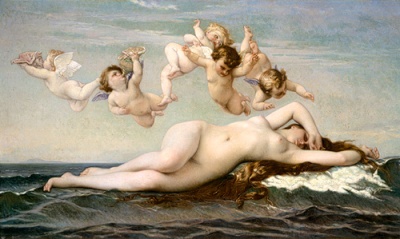
Birth of Venus
Alexandre Cabanel, 1875
oil on canvas, 41 3/4″ x 71 7/8″
Musee d’ Orsay, Paris
The nude in the foreground of Manet’s painting is sitting in a casual, almost intellectual pose. She is not preoccupied with presenting herself to the viewer, but acts as though the viewer’s gaze may be interrupting her conversation. Although nude, she is not sexual in pose. The lack of sexual accessibility in her pose gives her power. In contrast, Venus’ supine pose expresses passivity and sexual submission. Her pelvis is tilted toward the viewer as to display herself for viewing. Her breasts are fully exposed and her arms are away from the body as not to block its view. Instead of using her hand, her knees are slightly bent as to hide her pubis in shame. Although this is not the pure Venus pudica pose, it conveys the same traditional body language. The viewer has power and ownership of Venus’ sexuality.
In Manet’s painting, the nude female in the foreground looks directly at the viewer. The viewer cannot help but to lock into her gaze and acknowledge her as an individual woman. Because she is now an individual, she cannot easily be objectified; she has individual power. With her power, she seems to own her nudity and her sexuality. She is aware of her circumstances and has made the choice to be nude, hence her discarded clothing within her reach. The viewer is given access to her with limitations. Venus, in Cabanel’s painting, is painted true to academic standards. She does not gaze at the viewer and perhaps is not in a state of awareness. She does not engage or ask anything of the viewer. She is in a state of mind separate from the viewer so the viewer is free of limitations to fantasize and look upon her as an object of beauty and sexual desire. This sets the viewer up as a voyeur and owner of the viewed.
Manet painted The Luncheon on the Grass in a contemporary and realistic setting. Bowness states that two naked women having lunch in the woods with two elegantly attired men suggest impropriety. The context forces the viewer to see ordinary people in an ordinary environment. It is more difficult to objectify a woman who is not mythological or placed in a fictitious setting. Venus, on the other hand, straddles the line between being real and being mythological. She is painted in a fictitious setting with cherubs flying about and her body floating on top of waves. Venus as a real woman is abstracted and therefore represents an ideal.
As is seen from the comparison, Manet makes his viewer uncomfortable. For the first time, the viewer is not handed the ownership of the nude female’s sexuality. The viewer stands confronted with her power, her raw sexuality and without the systems in place which provide comfort to viewers of nudes painted by artists of the classical tradition. The viewer stands unprotected. These ‘systems of comfort’ include objectification though passive pose and gaze and placing the nude in a surrounding that often allows her to straddle the line between real and divine. The viewer has to allow the woman in the foreground to control and own her own sexuality. This breaks new ground in two ways. First, giving the woman in Manet’s painting freedom, forces the viewer to think about giving all females their sexual power, and secondly the viewer cannot easily get sexual satisfaction from the woman in the foreground, which is sought and expected from the nude in the painting, The Birth of Venus. Cabanel uses the traditional methods to pad the viewer’s sexual experience, making it satisfying and comfortable.If nudes in art were, in essence, seen as a means of sexual gratification, Manet’s nude would cause the viewer irritation because her image needs to be intellectually processed and cannot be simply viscerally responded to.
The birth of Modern Art allowed artists to challenge the traditional views of feminine sexual power in art, put into place by Praxiteles and his Venus pudica pose. Manet’s painting, The Luncheon on the Grass was a critical painting in breaking the social conventions of female sexuality and shifting the power dynamics in the traditional viewer’s experience. This new viewer’s experience, initially met with resistance and shock, paved the way for future artists to further visually explore the complex issue of the female nude and the ownership and power of her sexuality.
Notes
[1] Nanette Salomon, “The Venus Pudica: uncovering art history’s ‘hidden agendas’ and pernicious pedigrees,” in Generations and Geographies in the Visual Arts: Feminist Readings, ed. Griselda Pollock (London: Routledge Press, 1996), 70.
[9] H.H. Arnason and Elizabeth C. Mansfield, History of Modern Art , 6th edition (Upper Saddle River: Prentice Hall, 2010), 3.
[10]Ibid., 30.
Bibliography
Arnason, H.H. and Elizabeth C. Mansfield, History of Modern Art. 6th edition. Upper Saddle River: Prentice Hall, 2010.
Salomon, Nanette. “The Venus Pudica: uncovering art history’s ‘hidden agendas’ and pernicious pedigrees.” In Generations and Geographies in the Visual Arts: Feminist Readings, edited by Griselda Pollock, 69-87. London: Routledge Press, 1996.
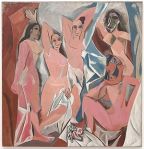 Professor Shad Wenzlaff, at Edgewood College, recently asked his Art History class to site works of art that they considered beautiful and others they could consider Sublime.
Professor Shad Wenzlaff, at Edgewood College, recently asked his Art History class to site works of art that they considered beautiful and others they could consider Sublime.



